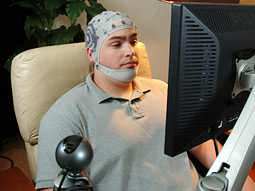Your Brain on Super Bowl Ads
 For the last few years, while fans have been recovering from an excess of guacamole and sports analysts were explaining why the winning team actually prevailed (scored more points?), small teams of neuroscientists have been at work doing their own post-game analysis: measuring which ads lit up viewers’ brains. (I’ve written about some of the past efforts in Super Bowl Ads: Brain Dead and Super Bowl Ads: GoDaddy Girl 1, Neuroscientists 0.) For the 2008 Super Bowl, the ad analysis came from a new source: Advertising Age. Skeptical of neuromarketing in their most recent article, AdAge traveled to Batavia, Ohio, to watch neuromarketing startup Sands Research hook subjects up to electroencephalography machines as they viewed Super Bowl ads.
For the last few years, while fans have been recovering from an excess of guacamole and sports analysts were explaining why the winning team actually prevailed (scored more points?), small teams of neuroscientists have been at work doing their own post-game analysis: measuring which ads lit up viewers’ brains. (I’ve written about some of the past efforts in Super Bowl Ads: Brain Dead and Super Bowl Ads: GoDaddy Girl 1, Neuroscientists 0.) For the 2008 Super Bowl, the ad analysis came from a new source: Advertising Age. Skeptical of neuromarketing in their most recent article, AdAge traveled to Batavia, Ohio, to watch neuromarketing startup Sands Research hook subjects up to electroencephalography machines as they viewed Super Bowl ads.
I was happy to see that my own technology-unaided pick for the best Super Bowl ad, the Coke “It’s Mine” spot (featuring giant parade balloons vying for an equally large floating Coke bottle), also scored as the one which produced the most EEG activity.
When watching spots for caffeinated and alcoholic beverages, your synapses fire and are fully engaged. When watching anti-drug spots, you come pretty close to flat-lining…
Sands found that subjects’ brain activity soared for Coke’s “It’s Mine” ad featuring Macy’s Thanksgiving Day Parade balloons from Wieden & Kennedy, Portland, Ore., and Bud Light’s “Ability to Fly” ad from DDB Worldwide, Chicago.
But the fewest synapses fired for the Office of National Drug Control Policy’s ad from DraftFCB, New York, that showed a pusher’s lecture outside a pharmacy on the dangers of mom and dad’s prescription drugs. [From The Super Bowl Spots That Got Inside Consumers Heads.]
If there’s a cautionary note in this, it’s that mere brain activation levels don’t always indicate whether the ad accomplished its objective or not. Once again, in 2008 GoDaddy confounded the neurocritics. The Sands testing showed GoDaddy’s ad caused little brain activation, along with sexy ads from Victoria’s Secret and IceBreakers. GoDaddy, however, reported a massive 1.5 million web site visits by the time the game ended, with traffic continuing to pour in after the big event.
In short, don’t confuse brain activation with meeting your business objectives unless you have validated a particular response as significant for a desired outcome.
Still, it’s fun to go through the brain scan process with these costly and original ads, and we applaud AdAge and Jack Neff for doing so in a thoughtful manner.
